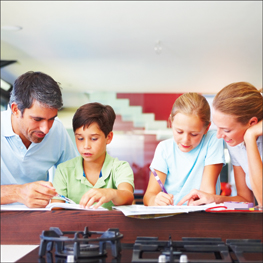
Once your children return to school, planning your time becomes even more vital to running your family life more efficiently and smoothly with less stress.
Use one planner. The easiest way to organize your time is with your paper, online or phone planner. Choose the system that works best for you. The most important action is to use your system every day.
Taking the time to plan actually saves you a lot of time, says Deniece Schofield, author of Confessions of an Organized Homemaker and several other organization books.
Some of her tips for planners include:
Purchase pages that give you plenty of space to write.
For more ideas, visit www.denieceschofield.com.
Use two planners. A mother of two who runs two businesses and works a full-time job, Crystal Layland uses two planners for success. She prefers the planner with 15-minute increments for each day. The detailed planning ensures she uses her time wisely.
At her job outside of her home, Layland uses her planner strictly for work assignments and meetings. She color codes with a highlighter her various activities for meetings, training and telephone calls. This planner stays at work. She plans for the next day before she leaves the office.
Layland carries her home planner with her at all times. It contains personal and business events and her children’s activities. Layland and each of her two children have a different color, as does her professional organizing and wedding planning businesses. She plans for the next day each evening. It only takes a few minutes, because it’s become an important habit.
Family reference notebooks. One of my favorite organizing ideas from Deniece Schofield, a nationally-known professional organizer, is her family reference notebook. It’s simply created with a binder and loose leaf paper. Your binder can include weekly planning sheets for the kids, including their activities and chore list, telephone directory of your children’s friends, and emergency contact information.
Schofield, the mother of five grown children, says the notebook prevents a lot of hassles. When one her children asked if he could go somewhere, she told him to check the notebook. Did he have another activity planned? Does he have chores to complete first? This habit can help you teach your family responsibility as well.
School papers, projects. Layland uses a binder to organize both of her children’s information from school and extracurricular activities. All papers, including calendars, policies, field trips, schedules, school contacts and others are filed into the binder.
She also keeps in her main family entryway a small bulletin board with upcoming events that the children like to look at.
Layland has made a habit of going through school papers immediately when they come home. She does not allow papers to sit and to pile up, which then takes longer to go through.
Layland constantly changes the children’s artwork, which she hangs on her refrigerator. She only keeps a few special items from each school year. These projects are stored in a rubber tote container, one for each child.
Backpacks, coats. Each of Layland’s children has a simple laundry basket in their main family entryway. Another option for families without entryways would be to keep baskets in the bedrooms. The kids put their backpack, along with an umbrella, bike helmets and shoes in it after school.
During the winter, Layland keeps a drying rack near the entryway, where the children hang their wet coats, mittens and hats.
School supplies. Layland maintains a bin of extra school supplies. Before they go school shopping, she goes through those items before she buys anything new.
The extra supplies also can be used for doing homework. She keeps supplies for their creative activities in another bin, which her kids can easily find when they’re looking for something to do after school or on the weekends. For more information about Layland, visit www.organizealamode.com.
Kim is a writer and mother of two daughters. For more information, visit www.seidelink.com.
Calgary’s Child Magazine © 2024 Calgary’s Child